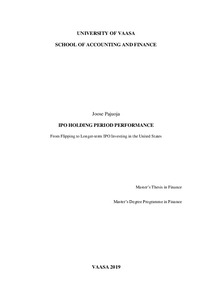IPO Holding Period Performance
Pajuoja, Joose (2019)
Kuvaus
Opinnäytetyö kokotekstinä PDF-muodossa.
Tiivistelmä
This thesis studies IPOs listed in the United States during 1998–2017. Points of inspection include prelisting underpricing and aftermarket performance. Underpricing is measured as price increase from the offer price to the opening price of the first trading day. Aftermarket returns are measured daily, starting from the opening price of the first trading day and span one year from the listings.
The well-documented and widely studied anomaly of IPO underpricing does not show signs of disappearing. The equally-weighted underpricing is 18,93% and proceeds-weighted average underpricing is 17,26% during 1998–2017 in the final sample, proving issuers still leave money on the table. The activity of IPO listing is higher when the economy has higher GDP growth. During times of high IPO activity, underpricing is also higher.
In the aftermarket, first-day returns average 2,65% and second-day returns average 1,07% for all the IPOs in the final sample. The positive initial aftermarket returns suggest that not all of the price increase is realized in the listing, but there is partial adjustment during the first days of trading. The average daily aftermarket returns of IPOs remain mostly positive until the expiration of the standard lockup period of 180 days. During the expiration of the lockup period. IPOs experience significant negative abnormal returns. The optimal holding period for IPOs is shorter than 180 days. A longer-term portfolio model including all IPOs is not able to create statistically significant returns when controlled with the Fama & French 3-factor and 5-factor models.
Business sectors with the best overall IPO returns include retail trade and services. Technology companies have high underpricing, but also high aftermarket returns, providing superior IPO returns compared to non-technology companies on average. Technology companies often achieve larger attention, coverage and expectations than IPOs of more traditional business sectors.
The well-documented and widely studied anomaly of IPO underpricing does not show signs of disappearing. The equally-weighted underpricing is 18,93% and proceeds-weighted average underpricing is 17,26% during 1998–2017 in the final sample, proving issuers still leave money on the table. The activity of IPO listing is higher when the economy has higher GDP growth. During times of high IPO activity, underpricing is also higher.
In the aftermarket, first-day returns average 2,65% and second-day returns average 1,07% for all the IPOs in the final sample. The positive initial aftermarket returns suggest that not all of the price increase is realized in the listing, but there is partial adjustment during the first days of trading. The average daily aftermarket returns of IPOs remain mostly positive until the expiration of the standard lockup period of 180 days. During the expiration of the lockup period. IPOs experience significant negative abnormal returns. The optimal holding period for IPOs is shorter than 180 days. A longer-term portfolio model including all IPOs is not able to create statistically significant returns when controlled with the Fama & French 3-factor and 5-factor models.
Business sectors with the best overall IPO returns include retail trade and services. Technology companies have high underpricing, but also high aftermarket returns, providing superior IPO returns compared to non-technology companies on average. Technology companies often achieve larger attention, coverage and expectations than IPOs of more traditional business sectors.
